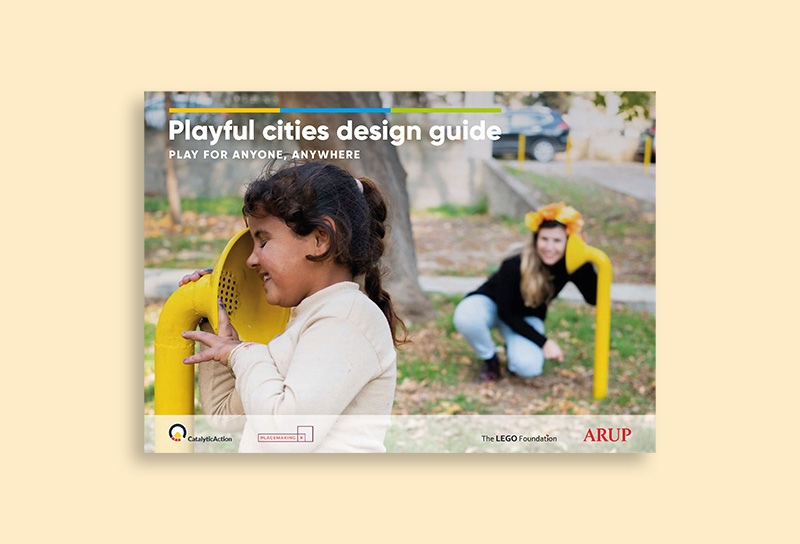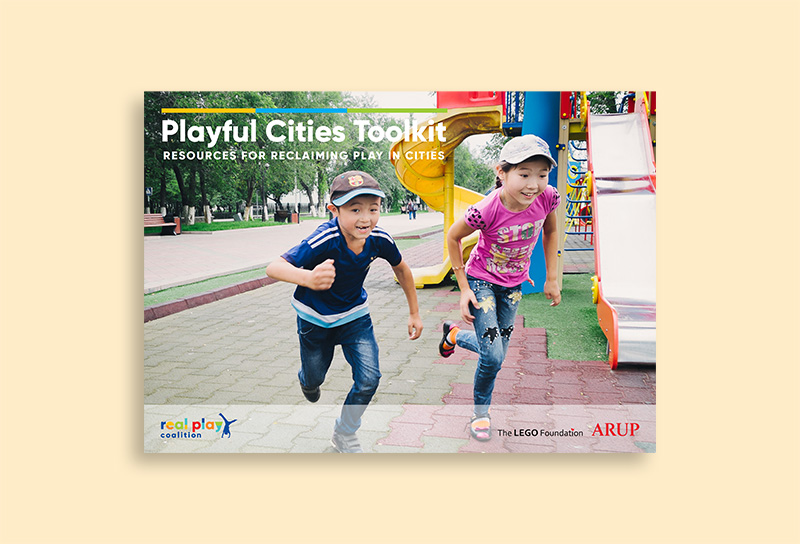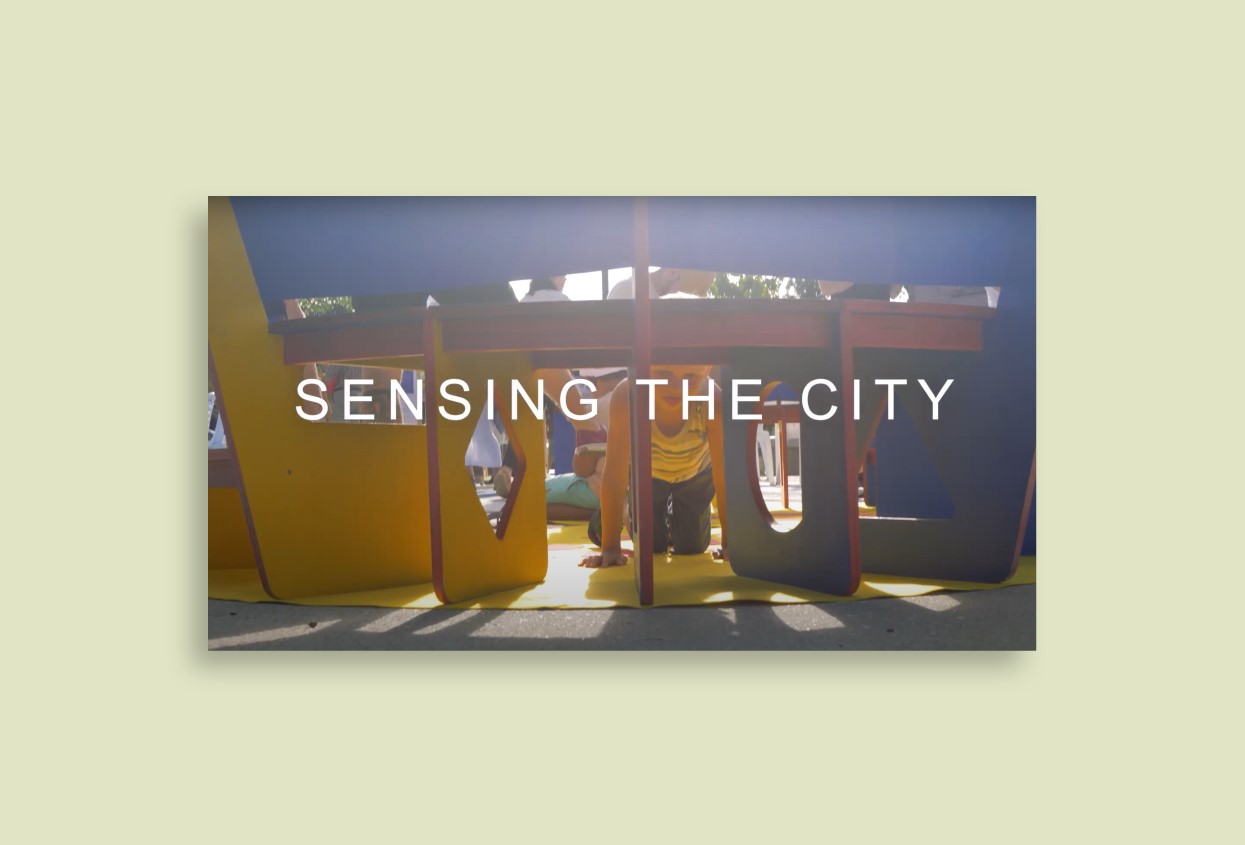
Overview
Location:
Jardim Nakamura, São Paulo, Brazil
Organisation:
Cidade Ativa
Partner organisations:
Municipality; Local community
Year:
2022
Scale of proximity:
Neighbourhood
Target beneficiaries:
Children 0-5; Caregivers
Reclaiming urban spaces for young children in Brazil inspired by local traditions
At Cidade Ativa, our non-profit design studio based in Brazil, we believe that urban design inspired by local traditions can be a powerful way to bring the community together and create opportunities for different generations to connect and learn from each other. Culture, local context and community engagement are key when designing interactive public spaces. Our traditions carry precious values and can be a powerful tool to inspire ideals when designing our neighbourhoods. These are core principle that we bring to all our projects, as well as creating more resilient, sustainable and healthier communities. In the summer of 2022, we took part in the Proximity of Care training program where we learned new perspectives, methods and approaches in understanding, designing and influencing early-childhood development.
The outcome of this training is our project ‘Ciranda’, where we aim to create engaging and playful spaces for children and their caregivers within the neighbourhood of Jardim Nakamura, a vulnerable community on the outskirts of Sao Paolo. The name Ciranda comes from a traditional Brazilian dance where children hold hands forming a circle. In this dance, connections are nurtured between one another and the whole group, and expressions of care and fun become interlinked. The form and meaning of the Ciranda dance serves as a metaphor for us to explain the values we want to support in the urban spaces of the neighbourhood, where we aim to transform an overcrowded and densely built neighbourhood with limited public space into one with the infrastructure of safe, nurturing and inclusive spaces. Whilst we have so far developed an understanding of our site and produced a concept design, we are still yet to implement our proposal.
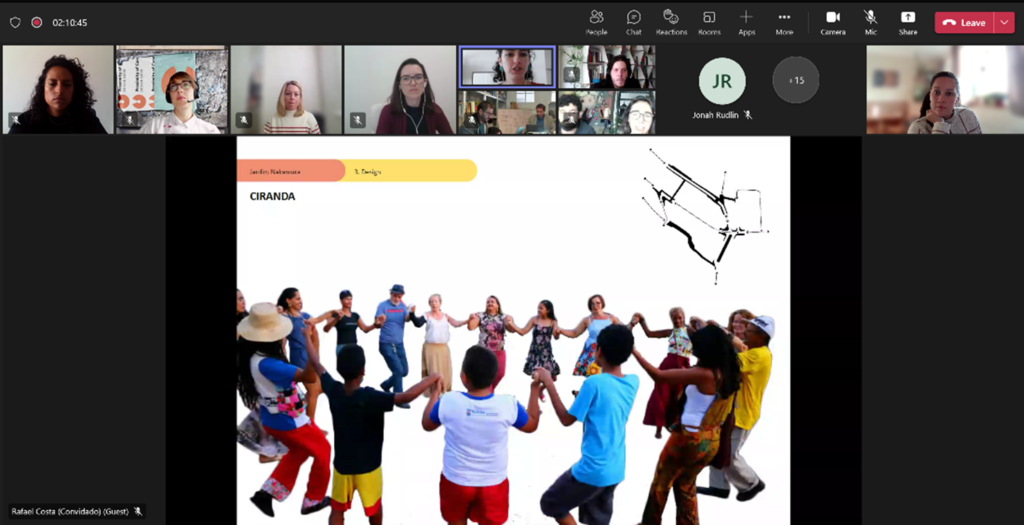
Folk dance as a design metaphor: discussing the Ciranda proposal as part of the Proximity of Care training programme.
Understanding the needs and opportunities of a community with sensitivity to the context
We have been working with the communities in Nakamura since 2014. Our work started with a micro mobility analysis of the area, understanding the complex and low-quality pedestrian network of streets, alleys and staircases, mapping and engaging with the local community and other key stakeholders. From this analysis we developd two projects on key staircases in the neighbourhood (an initiative we called “Mind the Step”), which were renovated with the provision of benches, greening, better lighting and above all, better community care and stronger connections to the local authority in terms of a maintenance regime. Multiple funding streams were used for this project, including in-kind and materials donations from businesses, as well as a grant from the UN-Habitat Global Public Spaces Programme. Our project Ciranda project has developed from these initial experiences and engagements, and focuses on upscaling the former impacts by conceptualising each initiative within the neighbourhood as part of a greater network of care.
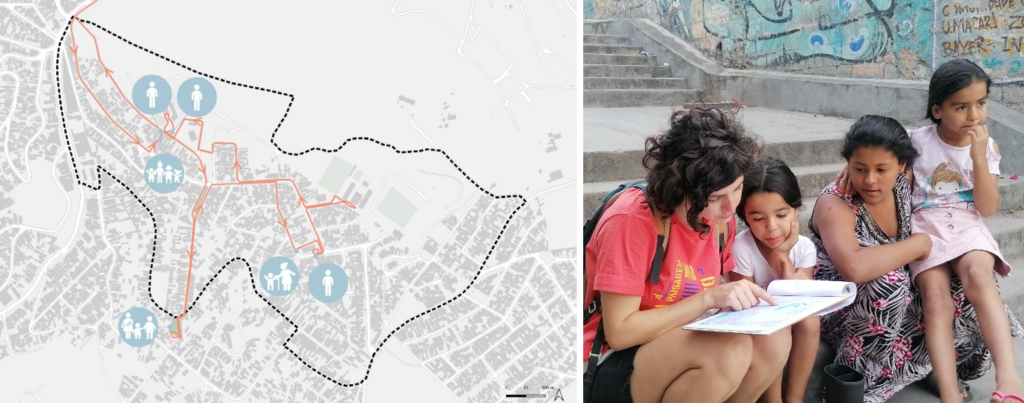
An analysis on mobility networks and practices in Nakamura was conducted through engagement with local young children and their caregivers.
To understand the challenges and opportunities for positive childhood development outcomes, we used a range of methods provided as part of the Proximity of Care approach: desk-based research and the analysis of the publicly available secondary data; local knowledge and experience from our team members working in the area; transect walks with children and caregivers; and stakeholder mapping.
Throughout this initial approach to understanding audience needs, we faced some external limitations. School holidays delayed our engagement plan since students and teachers are difficult to reach during these periods, and a pre-election period also had influence on the community’s involvement in the activities, making it take longer to gain trust and support. We therefore plan to conduct more thorough engagement and co-design activities in the next stages of our project.
We believe practitioners must be sensitive in engaging with communities to ensure a projects success, and we wanted to secure funding from donors and buy-in from the municipality before engaging with locals any further.
Designing a network of child-friendly spaces based upon the concept of the Ciranda
By reclaiming space from cars, our proposal aimed to improve protection and create stimulating places where unstructured play can take place. Streets, as one of the rare open spaces in Jardim Nakamura, are a resource for exploring possible ways for making child and family-friendly neighbourhoods. Street redesign, through traffic calming principles and the provision of safe areas for small children to interact and play, is an approach which attempts to rebalance the importance of people over cars. Installing temporary and permanent infrastructure and elements can support child sensitive facilities, connecting spaces through safe routes with amenities for pregnant people and caregivers.
Our concept design can be broken down into three concepts; ‘Hugs’, ‘Arms’, and ‘Ciranda’:
‘Hugs’ are interventions which target locations in proximity to school access areas and dangerous street corners. Their strategy is to transform these areas into protected and stimulating places, by providing enough space and opportunity to create car-safe environments where children and their caregivers of all ages can play, experiment and relax. They target the Proximity of Care Dimensions of Support, Health and Stimulation by incorporating elements and amenities such as play props, benches, public WiFi, areas for changing nappies and natural assets. The Hugs interventions are the largest areas we could reclaim, mostly on the housing block corners, gained by reducing the turning radius and made safe by using curbs and interactive protection elements.

Hug options for two locations in Nakamura, co-designed with local children. We used play dough as an approach to model-buildings with 3-5 year-olds.
‘Arms’ are linear interventions along streets and alleys that help us connect Hugs through safe and playful links, creating interactive surfaces and affordances to stimulate cognitive development. These interventions are less structural and make use of tactical urbanism strategies to invite children to safely explore the route.
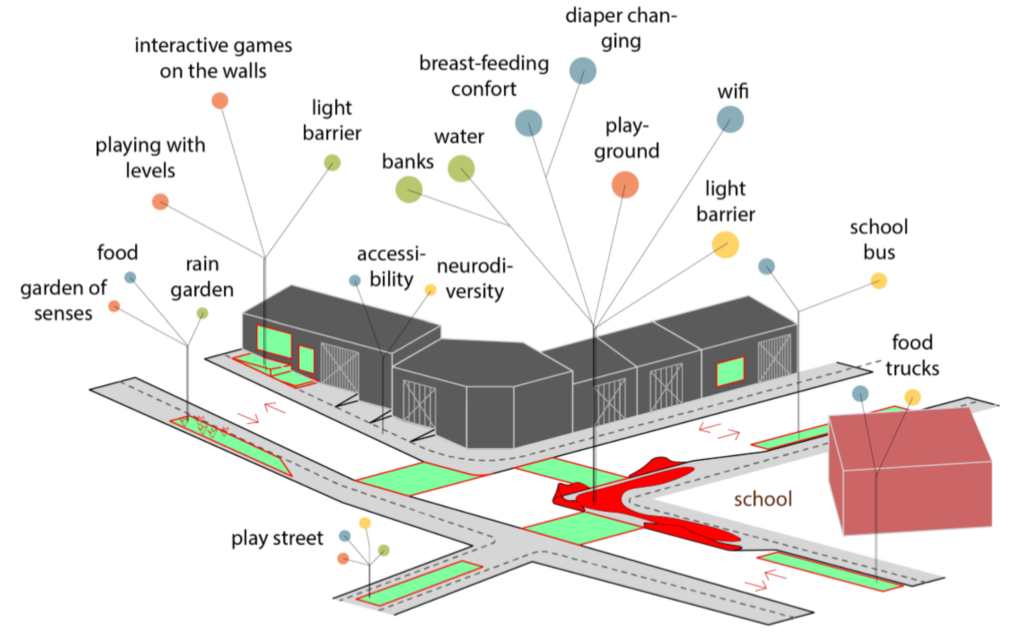
Concept design ideas for “Arms” and “Hugs”
‘Ciranda’ interventions are where it all comes together; a union of Hugs and Arms and a new element that arises on a neighbourhood scale. The aim of the Ciranda is to establish a social and physical network of care, stimulus, and protection that is made possible by improving a series of urban spaces that are currently unhealthy, unsafe and unattractive. This network of spaces, locations and features are designed regarding the Proximity of Care principles and expected outcomes.
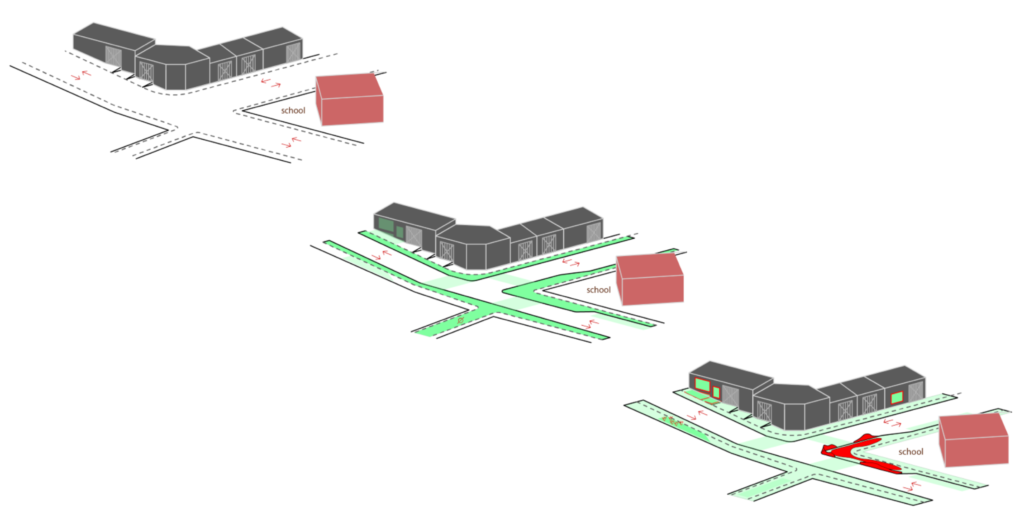
Left: Current situation with narrow footways, inaccessible routes and crossings, underused spaces for cars, lack of urban furniture and unsafe crossings. Middle: Arms are accessible, safe and playable routes that connect houses, schools, squares, mobility hubs and cultural spots. Right: Hugs are locations that have the potential to become catalysts for change in the area, and key spaces to form the network of the Ciranda.
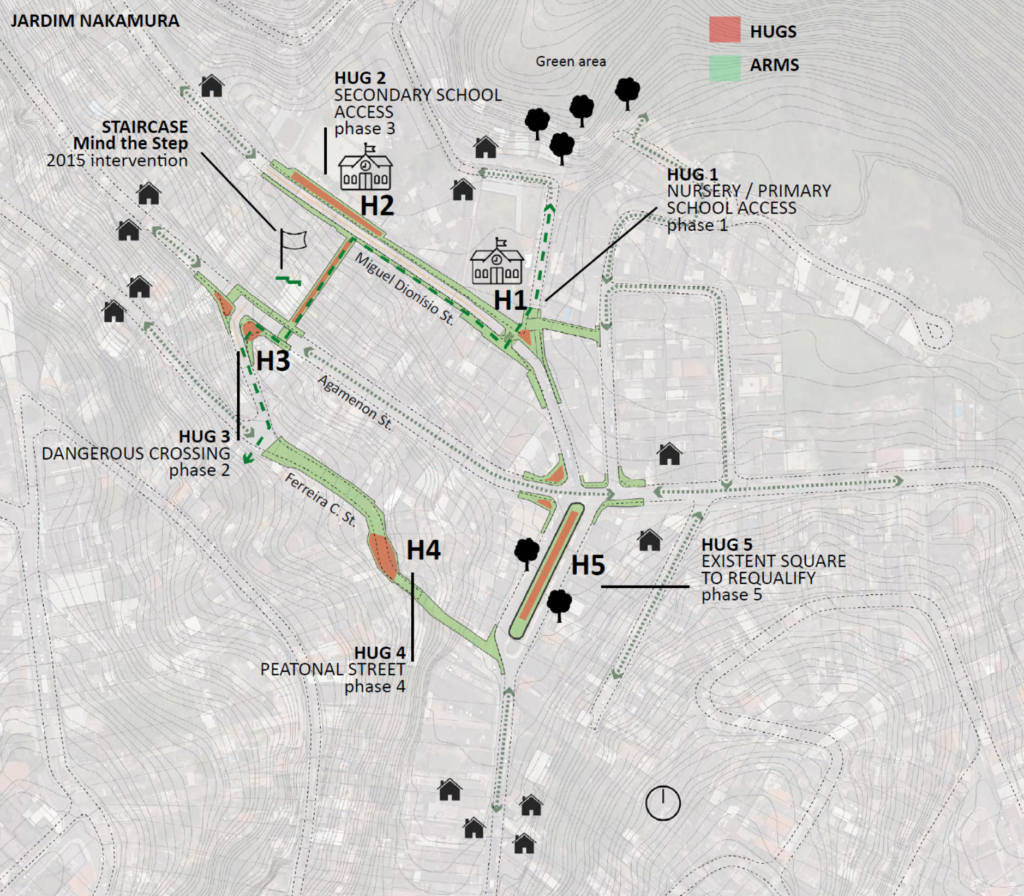
The Ciranda – a network of hugs and arms that transforms an overcrowded neighbourhood into a child-friendly infrastructure.
Our next steps in the project will be to secure funding and support for our concept design, and to continue to engage and validate our approach with the local community in Jardim Nakamura. We will also make sure to develop methods to measure the success of our project, both before and after the implementation, to continually reassess our understanding of how the local community are using the spaces. The other key success factor will be continued collaboration with the local authority, making sure our project aligns with their needs and capabilities where possible, and to enable a dialogue which can promote and influence early childhood approaches to urban policy in Sao Paolo.
Reflections on the The Proximity of Care Desing Guide
We found that The Proximity of Care Design Guide encouraged us to go further with our design, and to deeply consider how your project can support the multiple dimensions of early childhood development. Our key reflection on the process were:
(1) Using the Proximity of Care Design Guide can inspire and support a mainstream collaborative design process which takes into account the needs of young children, whilst working towards building better, healthier, safer and more stimulating cities and neighbourhoods for everyone.
(2) The 48 factors within the 16 goals and 4 dimensions might seem overwhelming at first contact, however they can bring a deep insight to the Understand phase.
(3) Field research, engaging with different groups, and incorporating children’s desires into the design is fundamental to deliver spaces tailored to the community. The Proximity of Care Framework supports this idea and brings together tools and experiences that can be adapted to each context.
(4) The Framework also provides important clues as to what elements might be most beneficial to consider and include under a holistic perspective during the design phase, even if the goals one decides to focus on do not intend to solve all the listed problems.
(5) The case studies presented, both for conceptual as well as design activities, can inspire you with new approaches and methods. By using the tools, case studies and principles, one can better design for multiple benefits considering, for example, children’s cognitive development, safety, and community engagement alongside each other.
(6) It is important to keep in mind that the framework is not a rigid step-by-step process to be strictly followed, but rather an inspiration and a set of tools that might be useful depending on each project, presenting key elements to keep in mind when designing for early childhood.
Links and sources:

